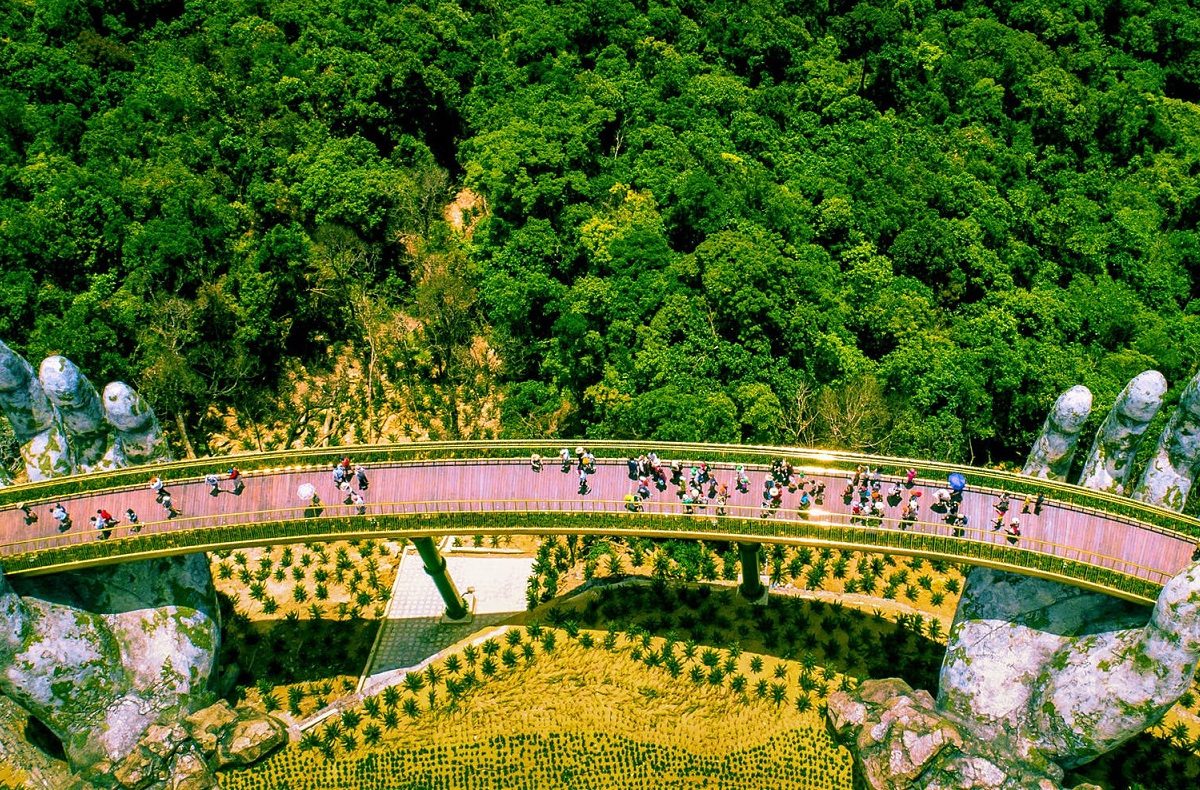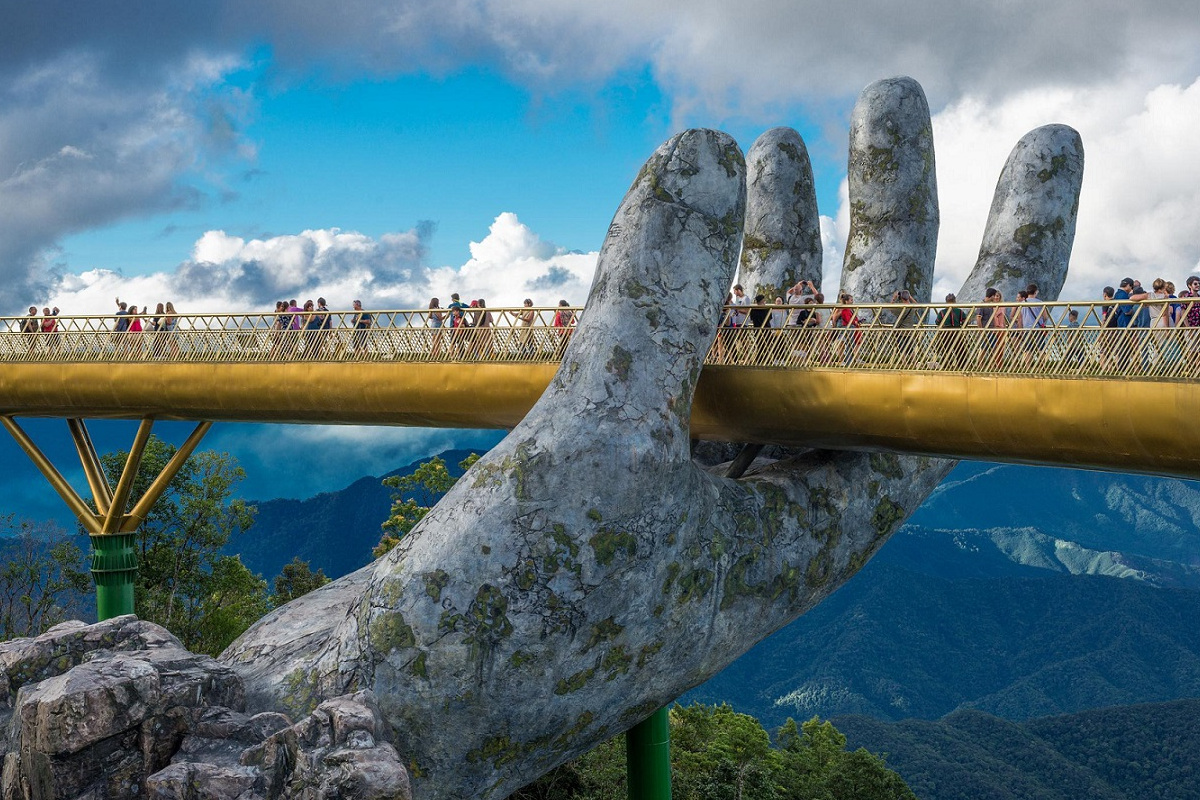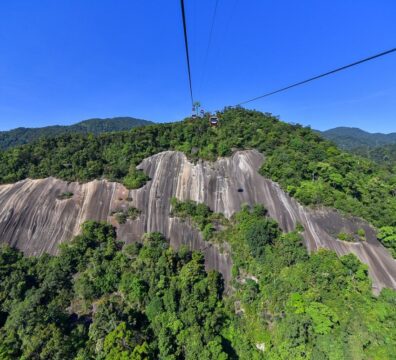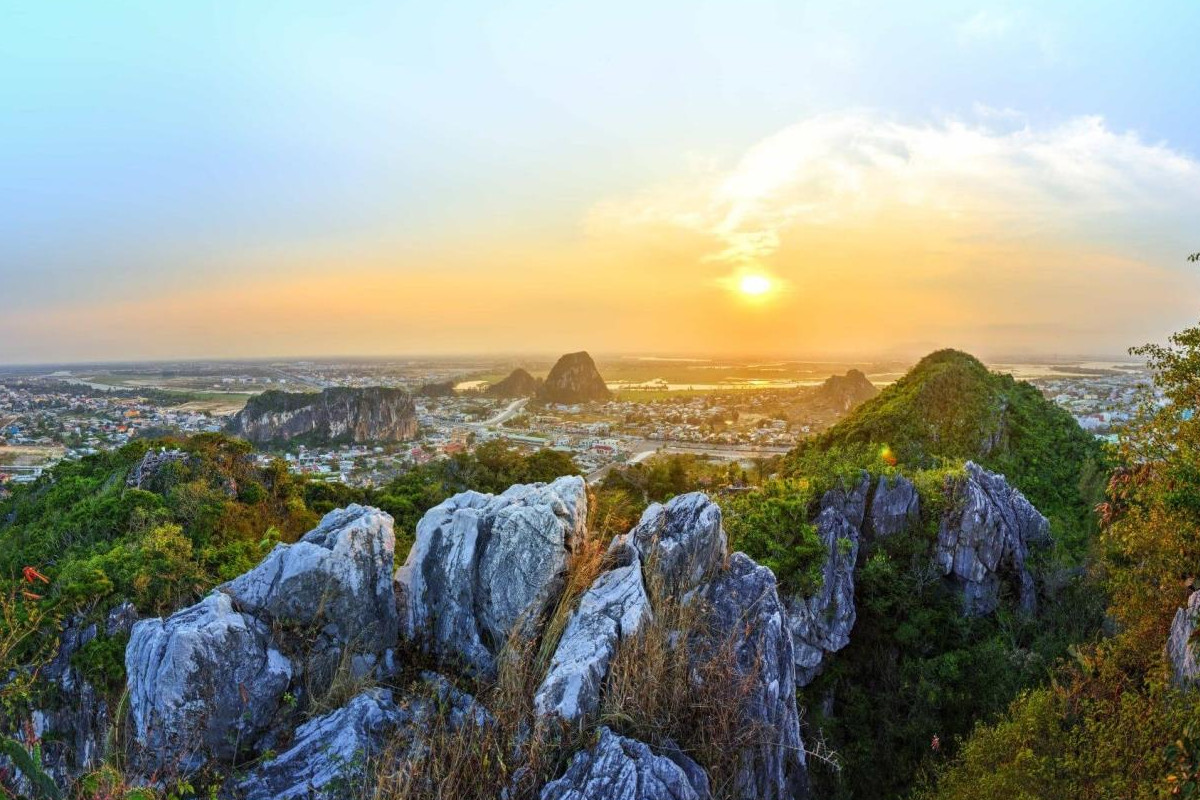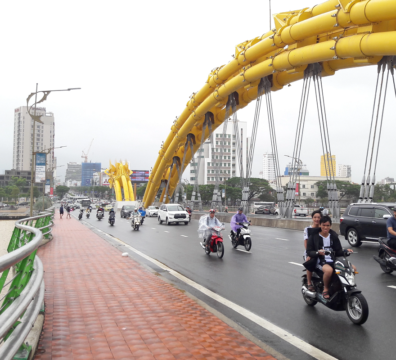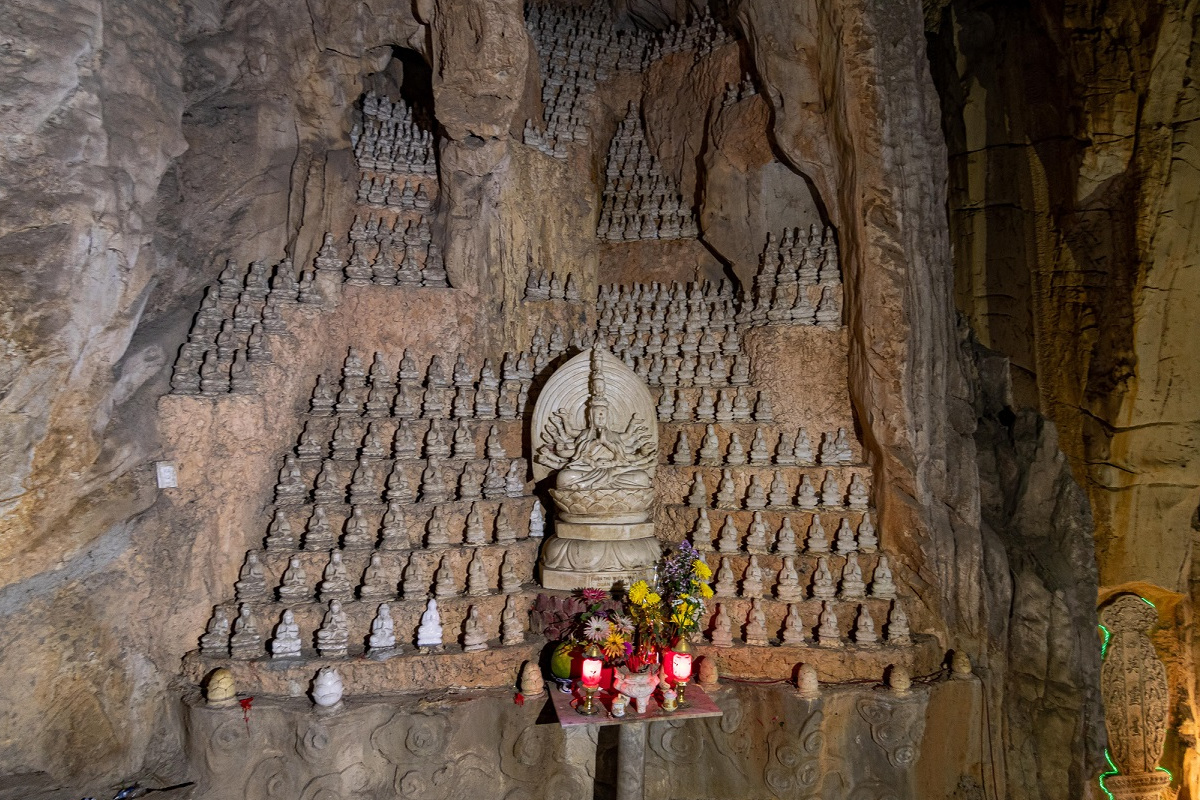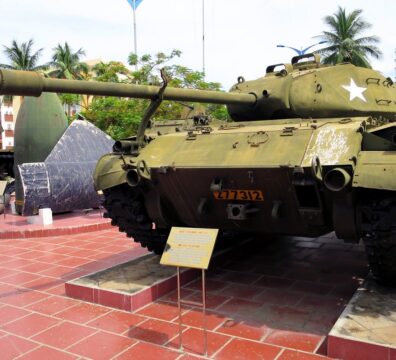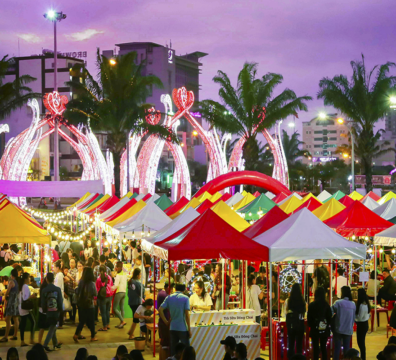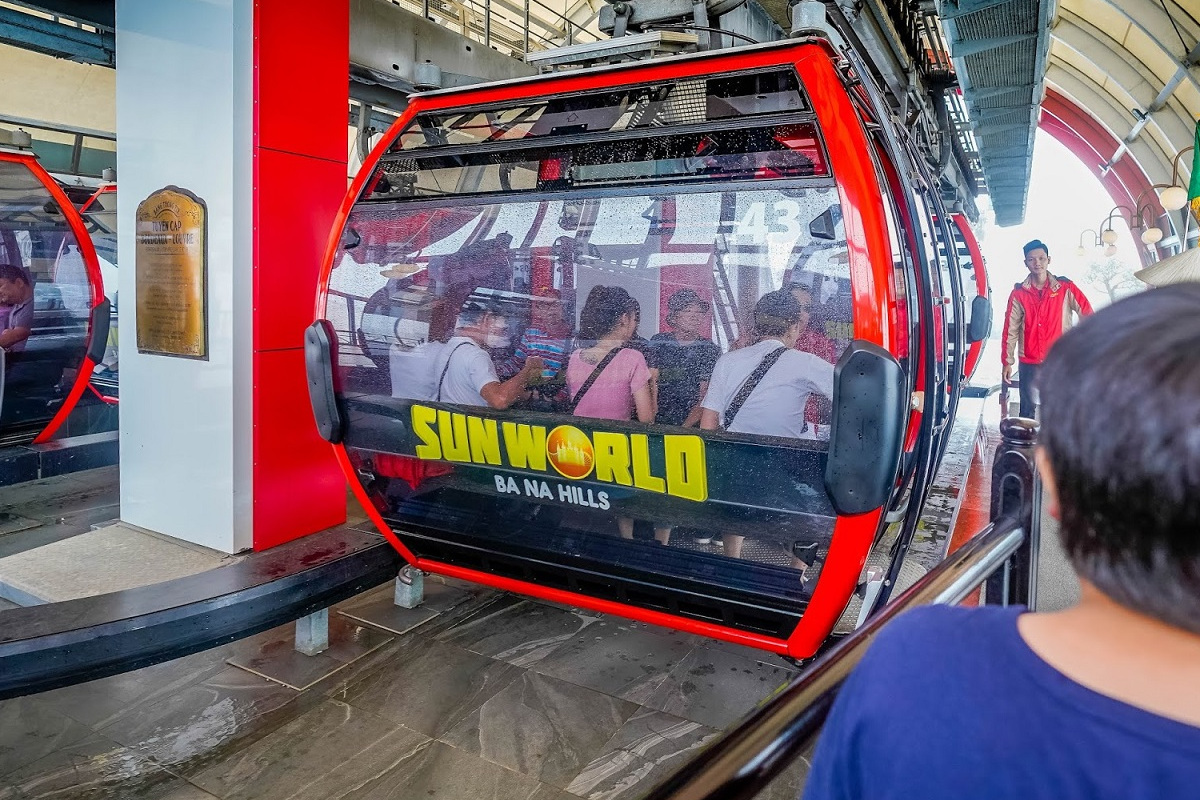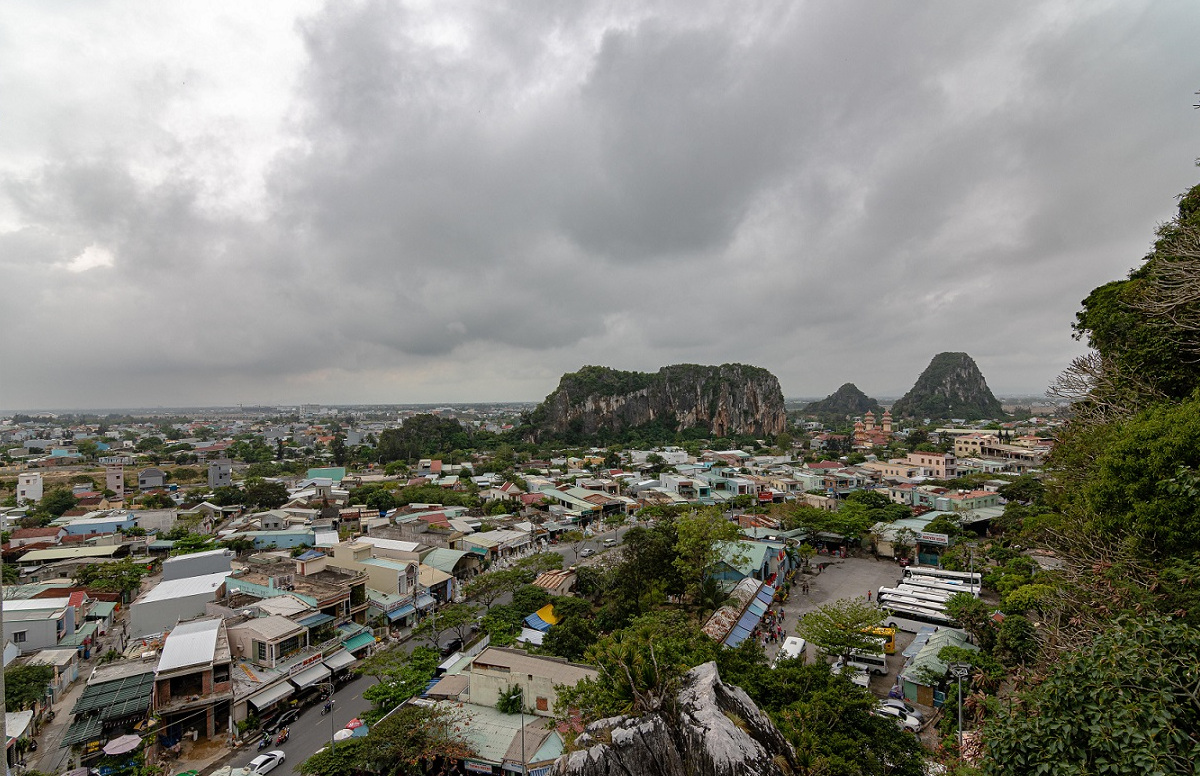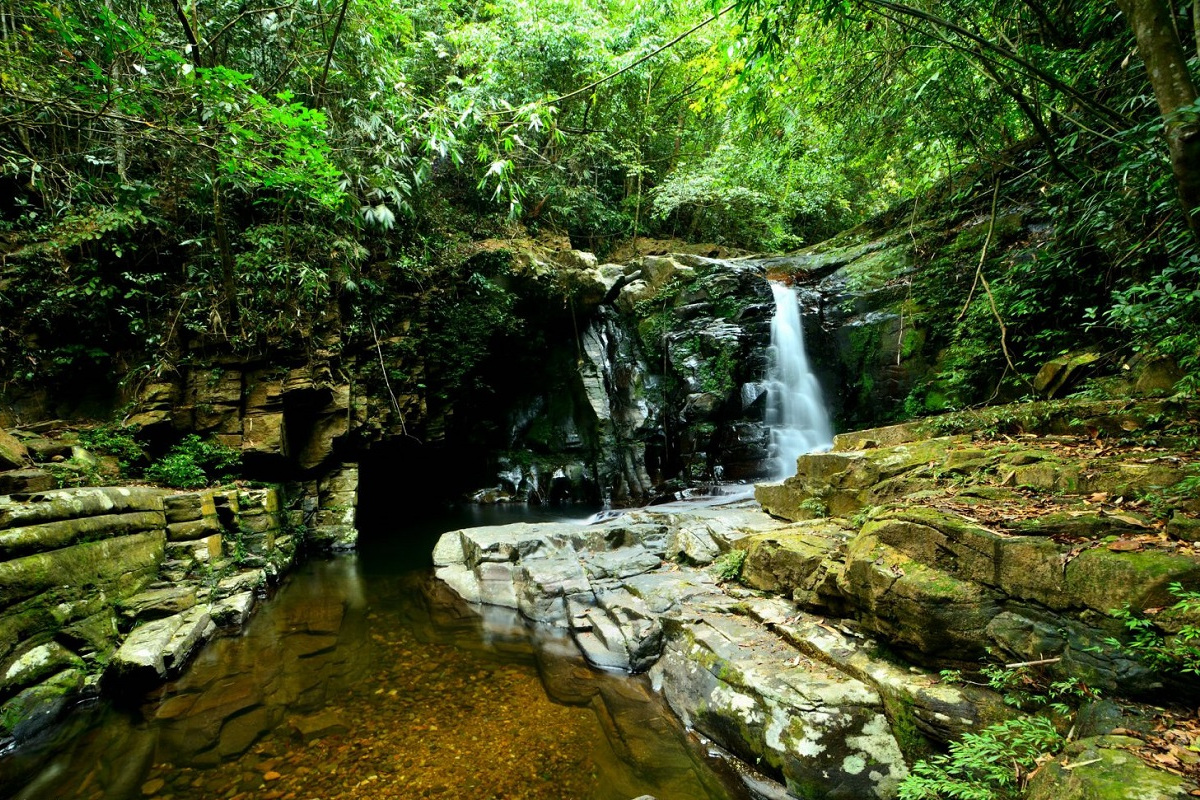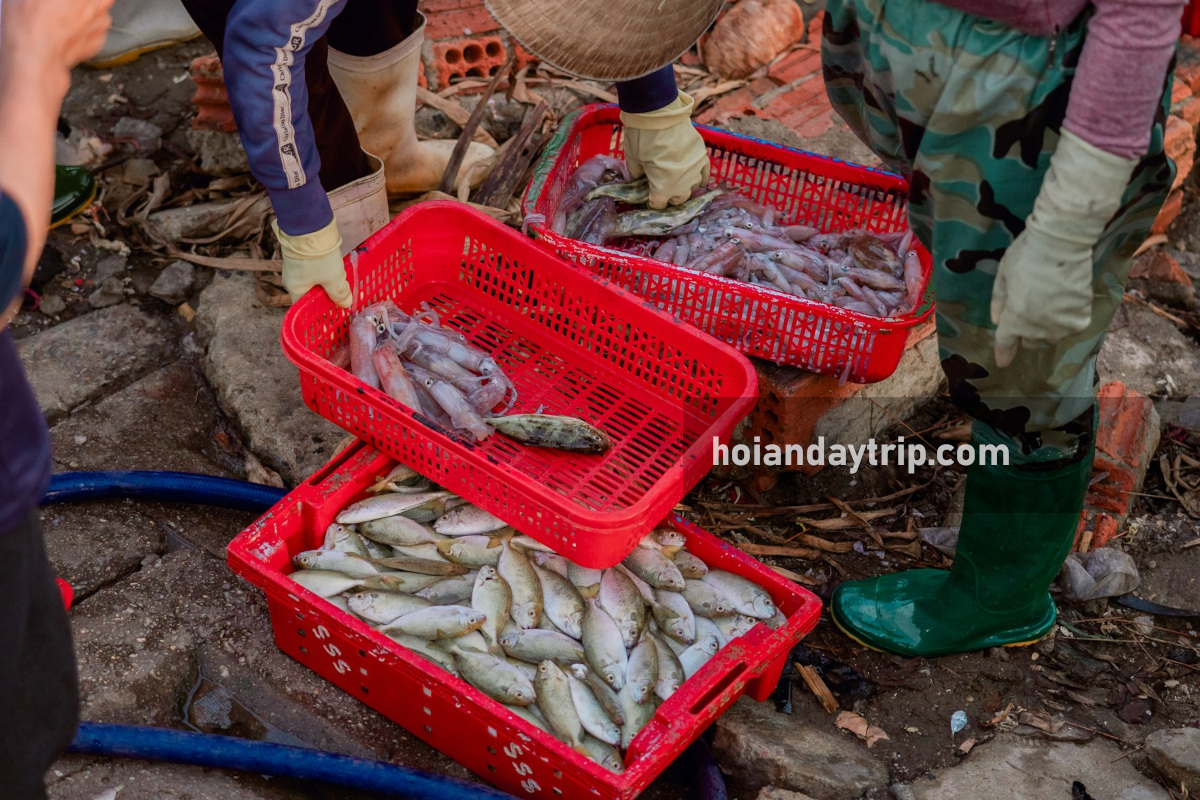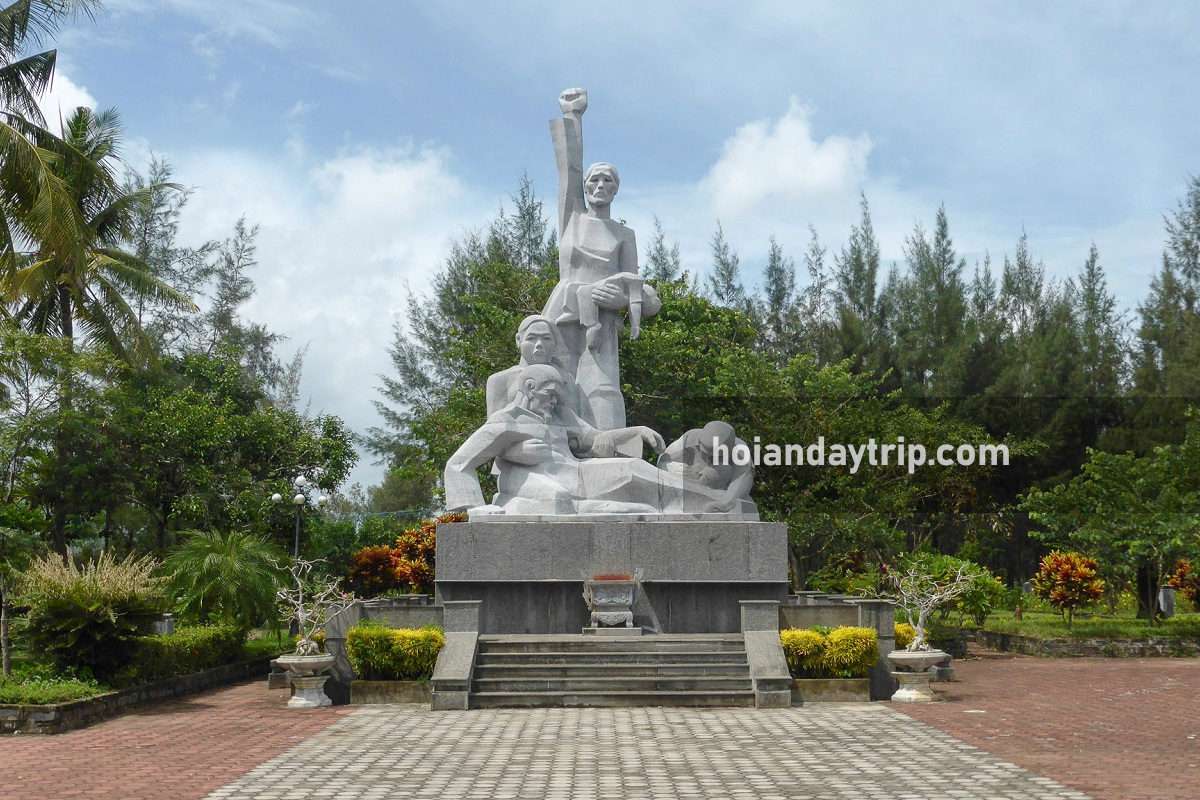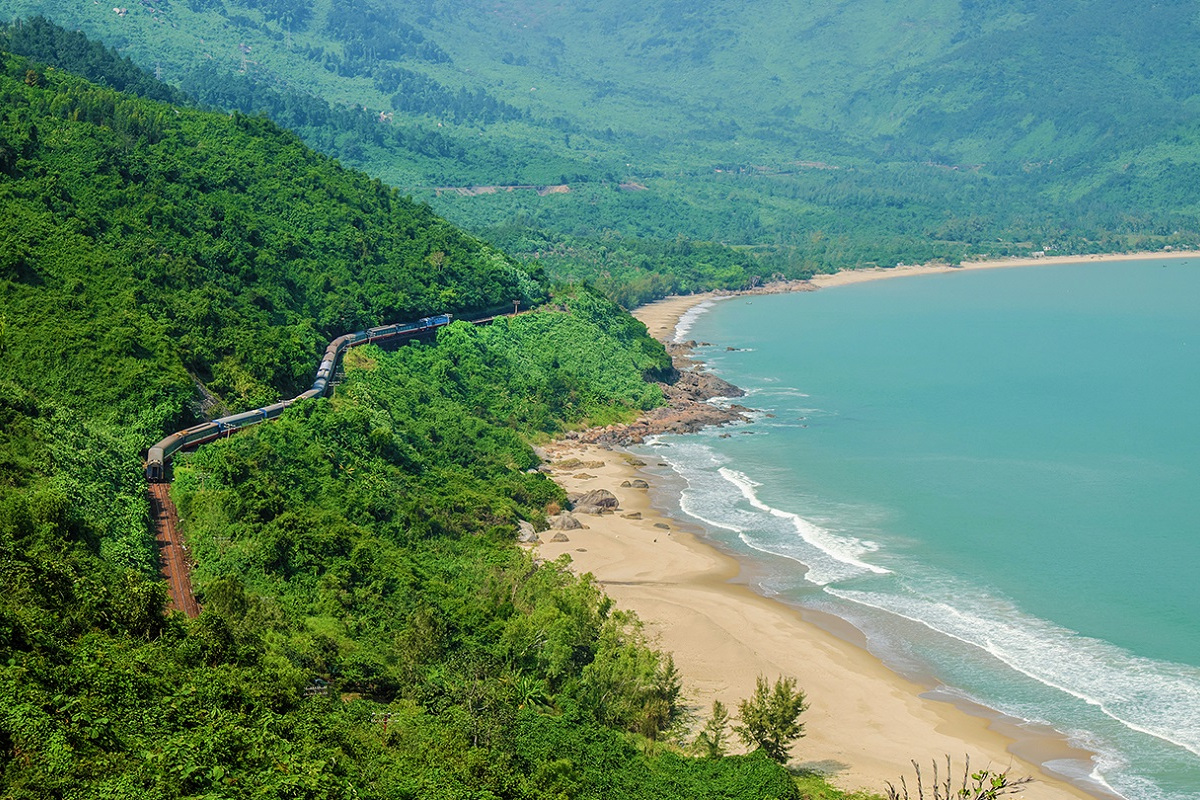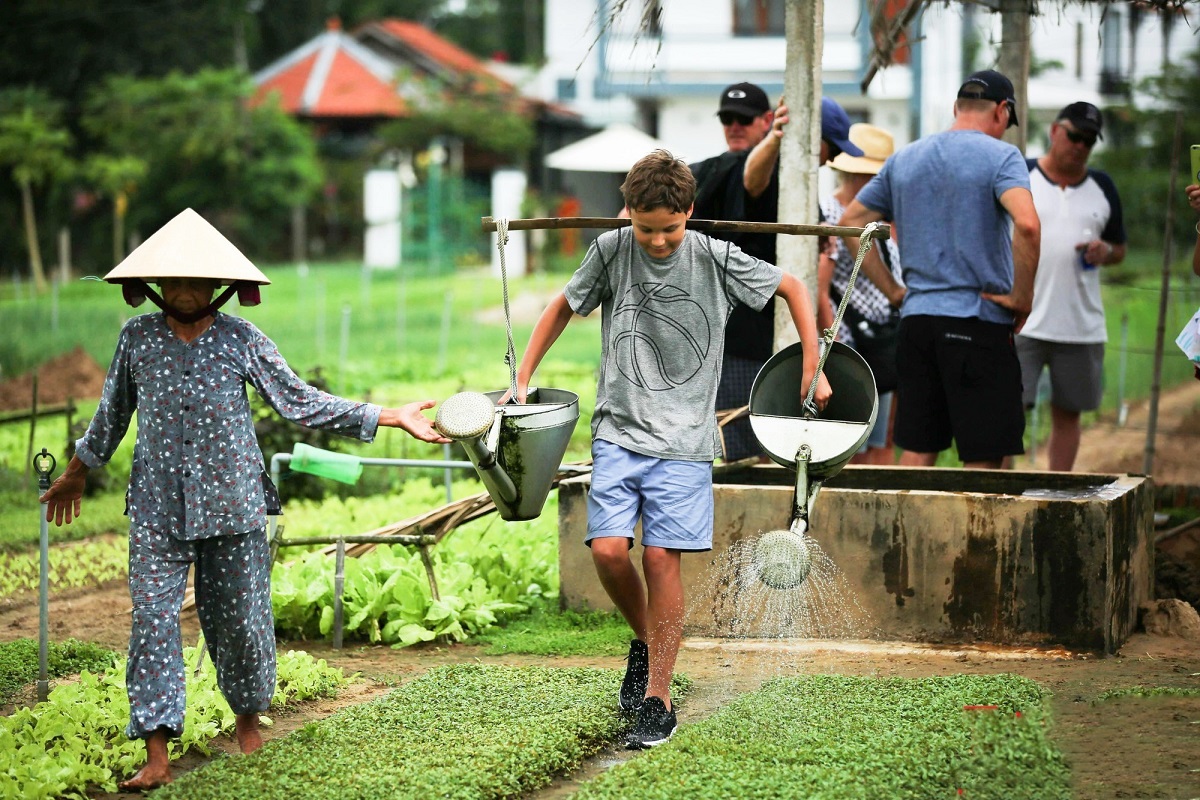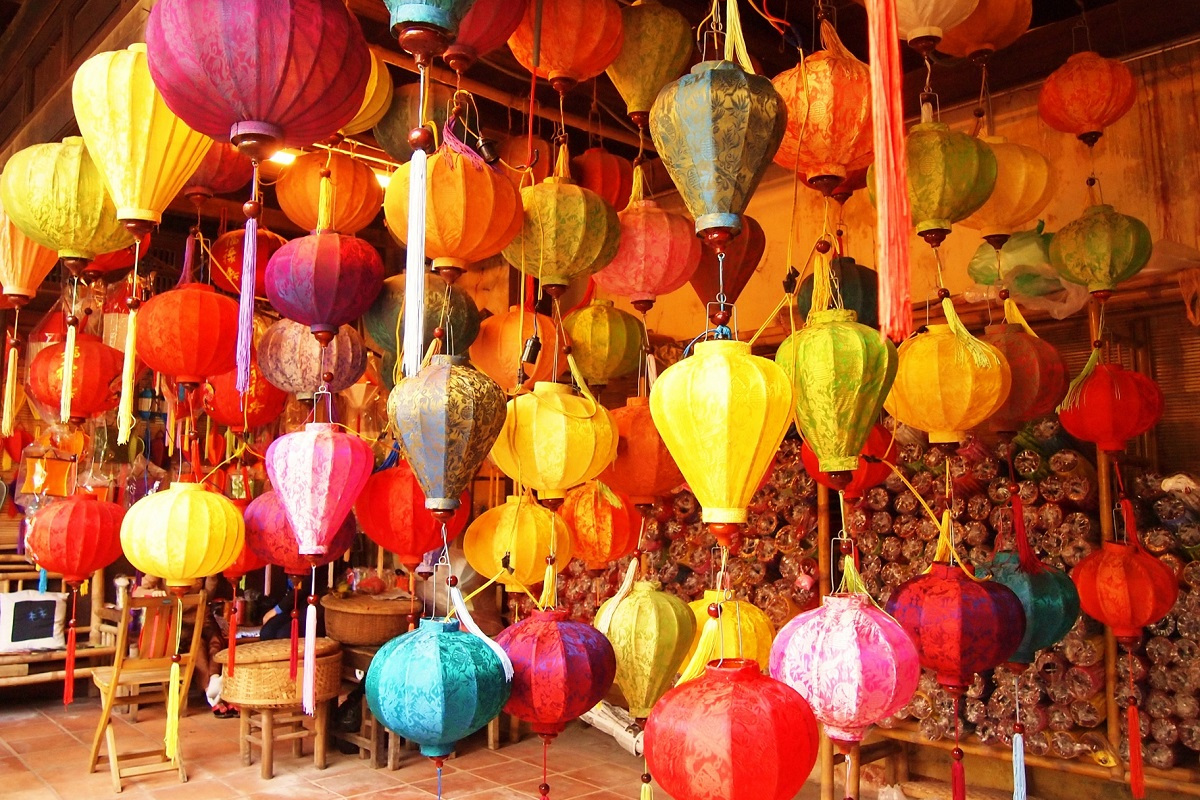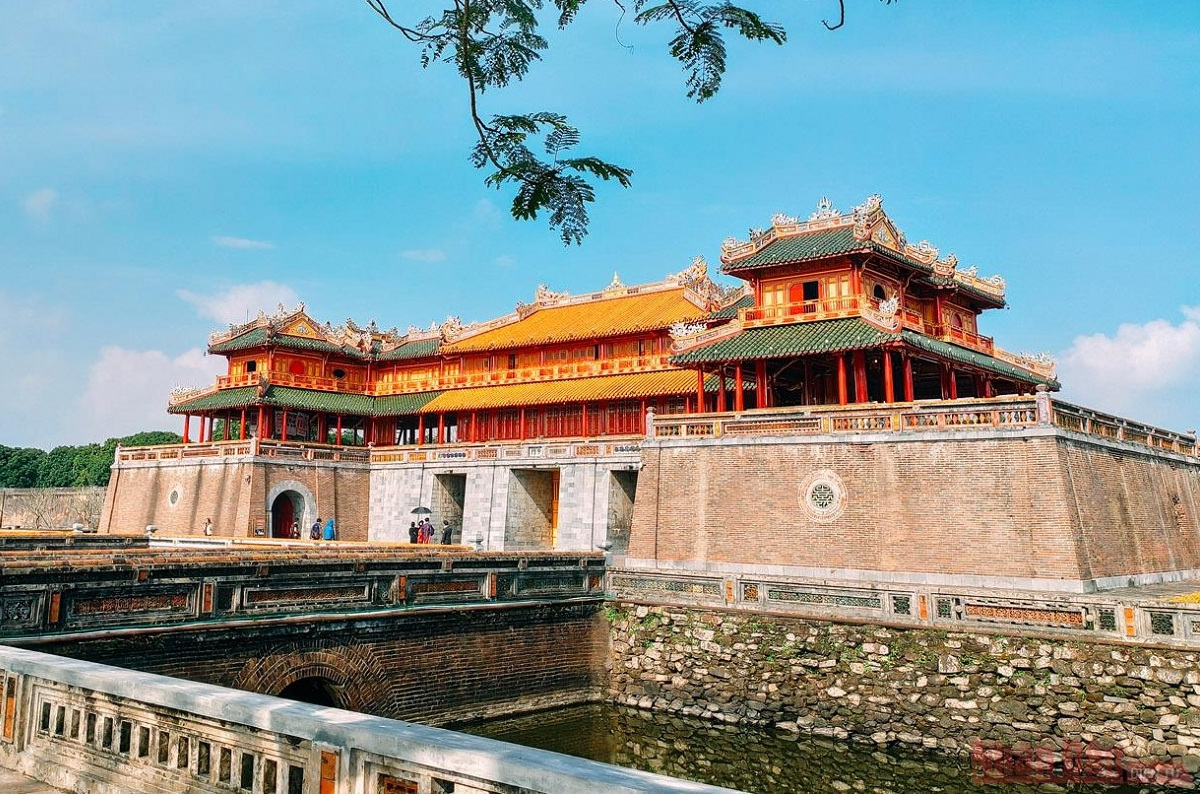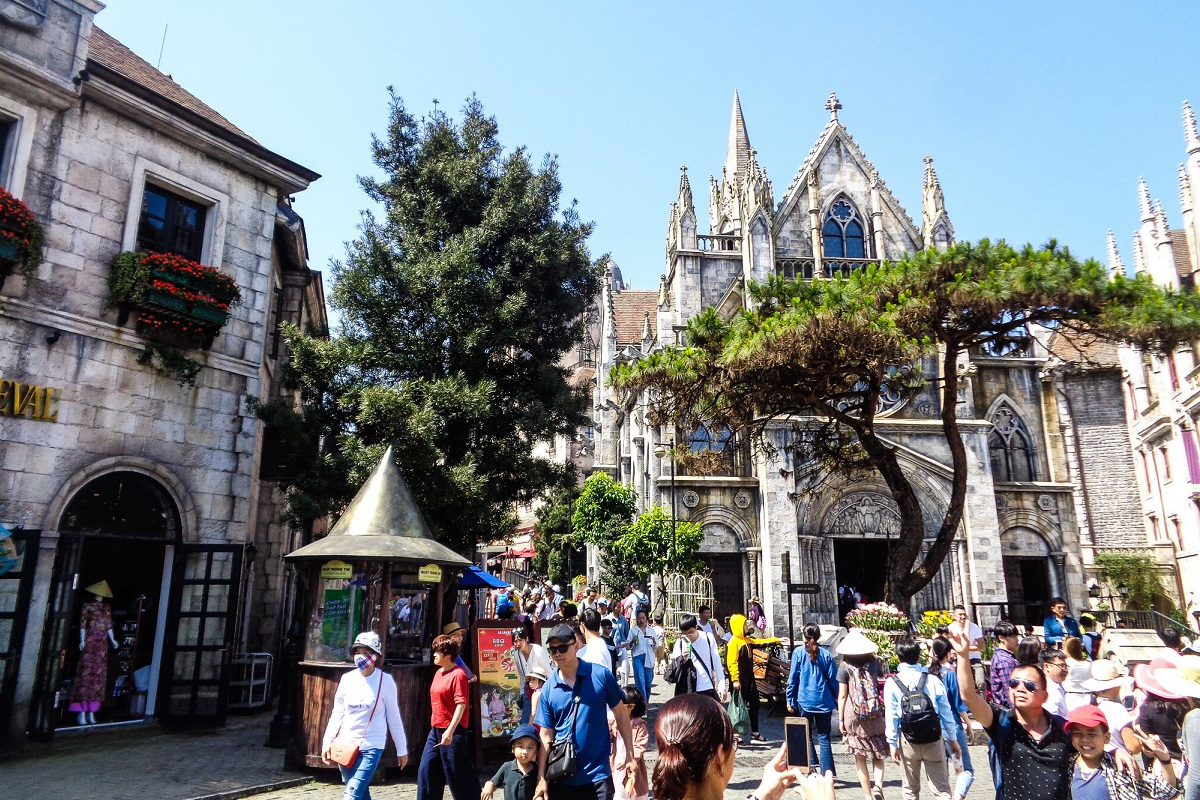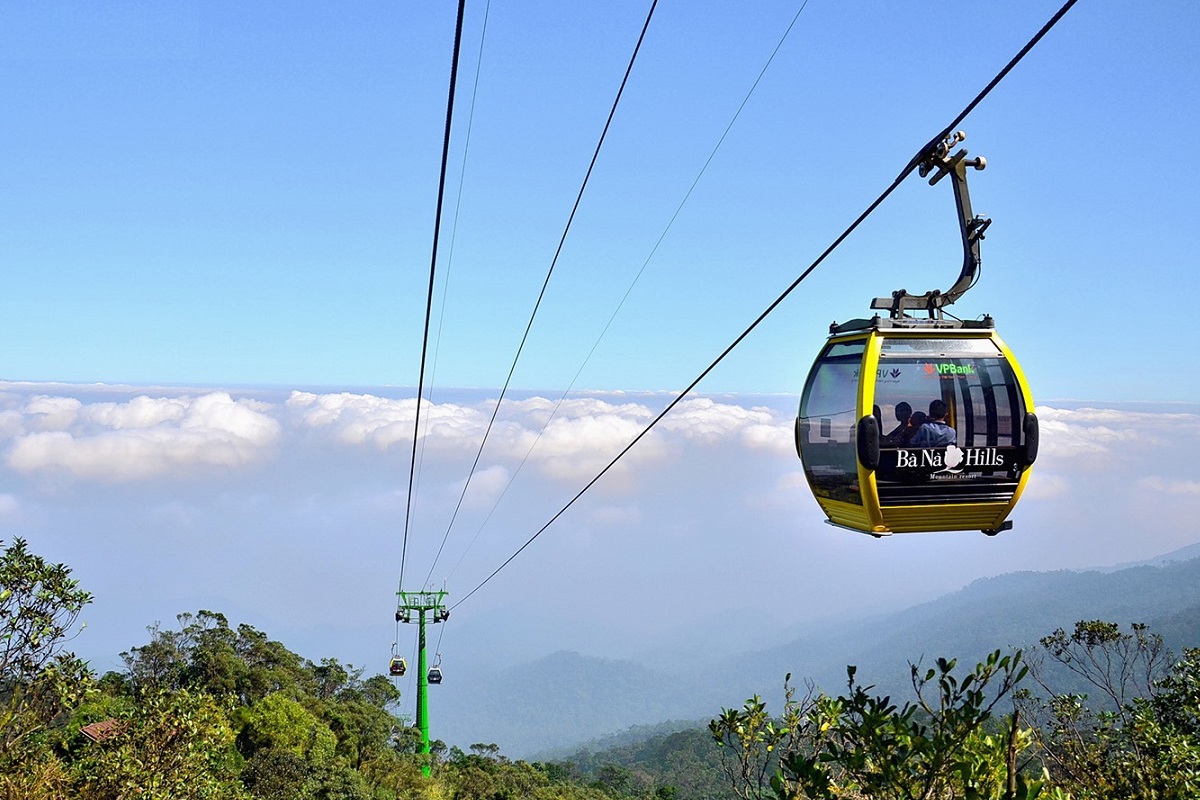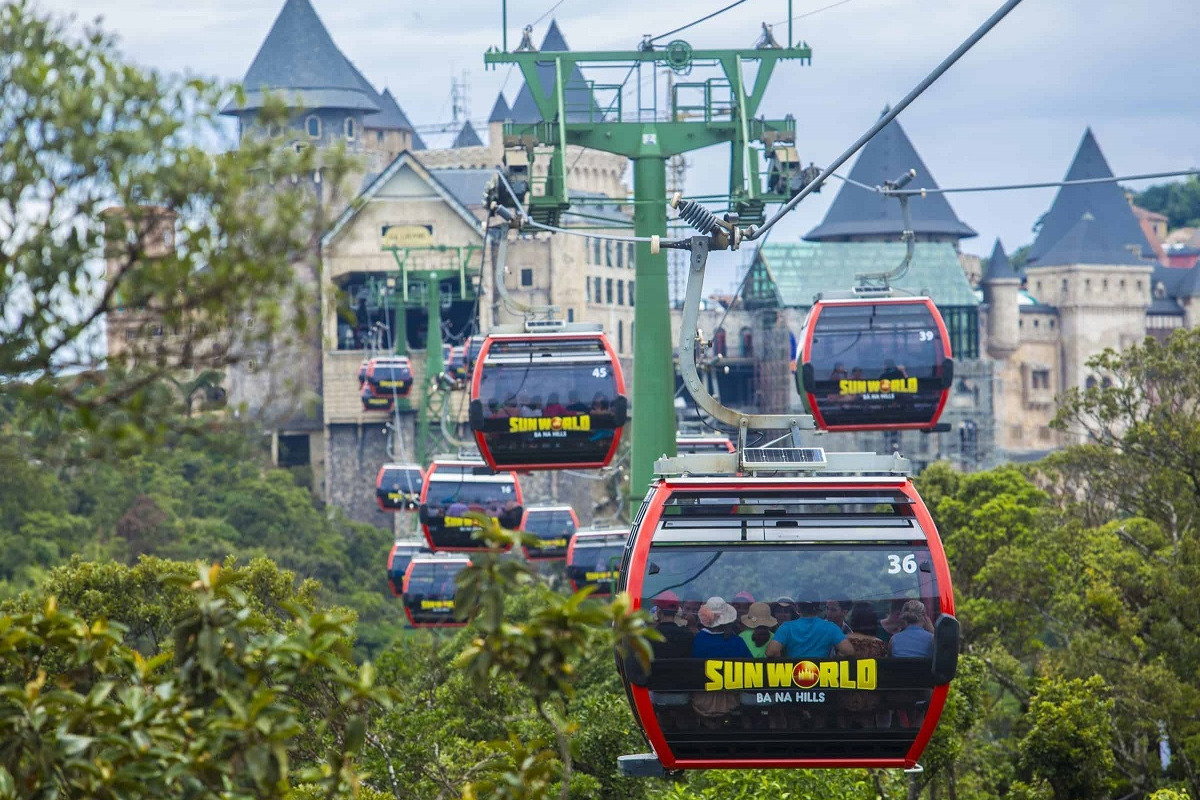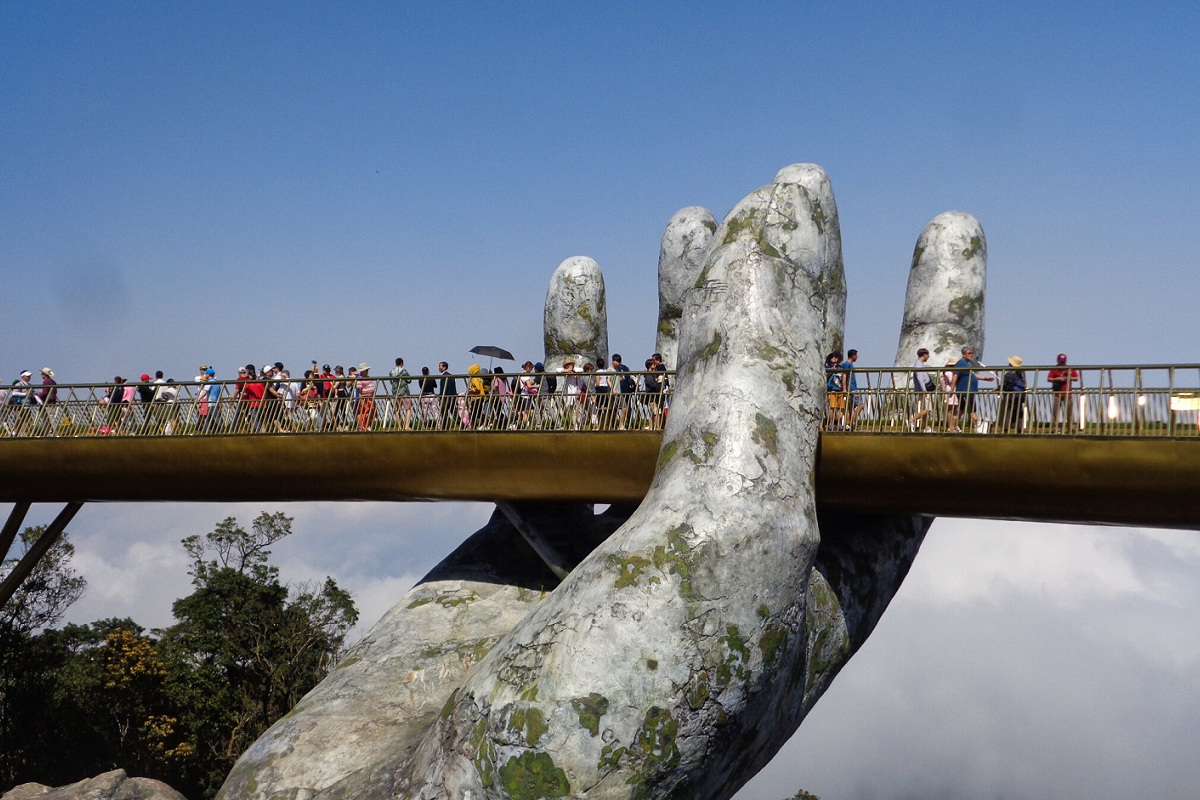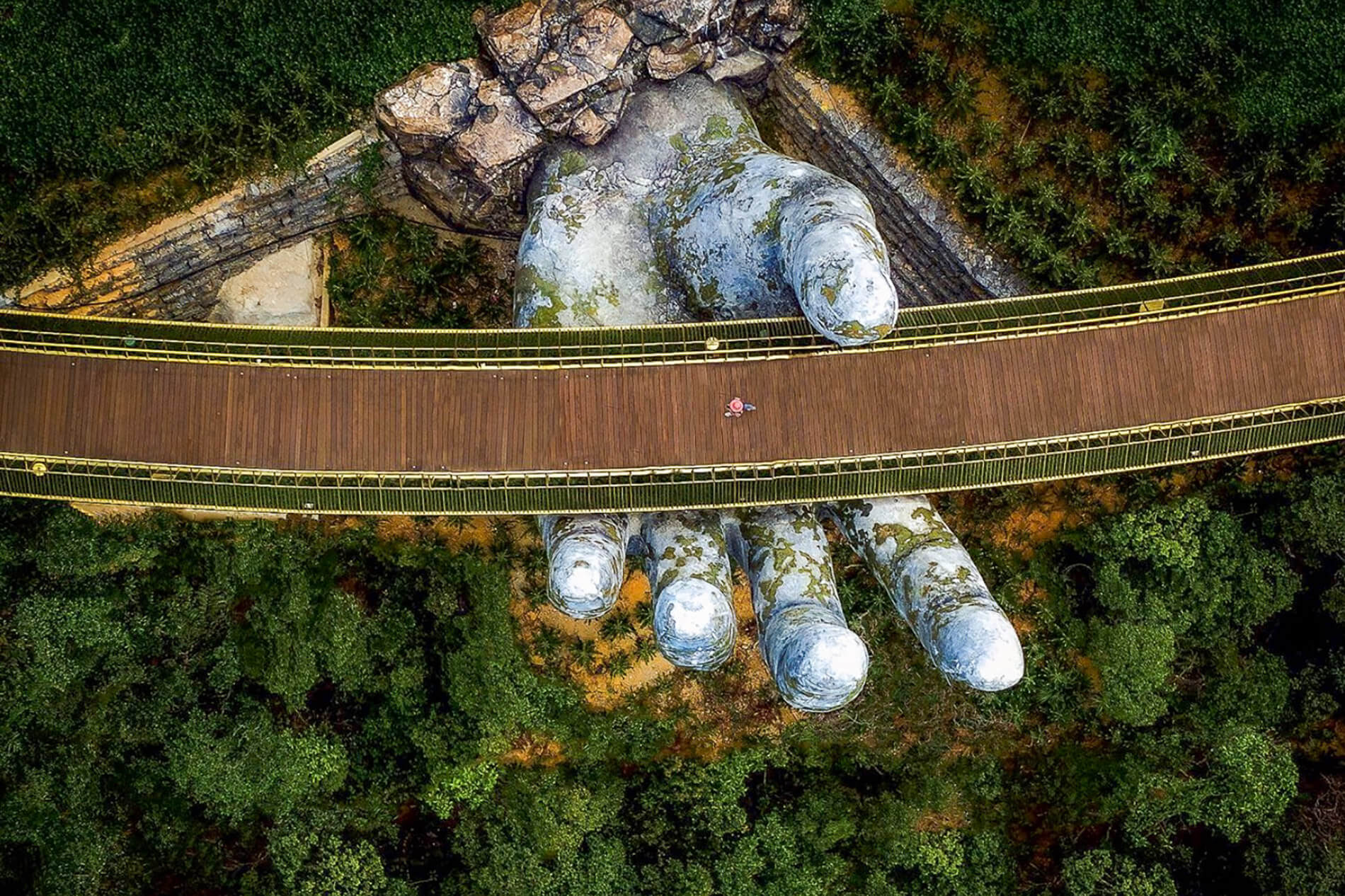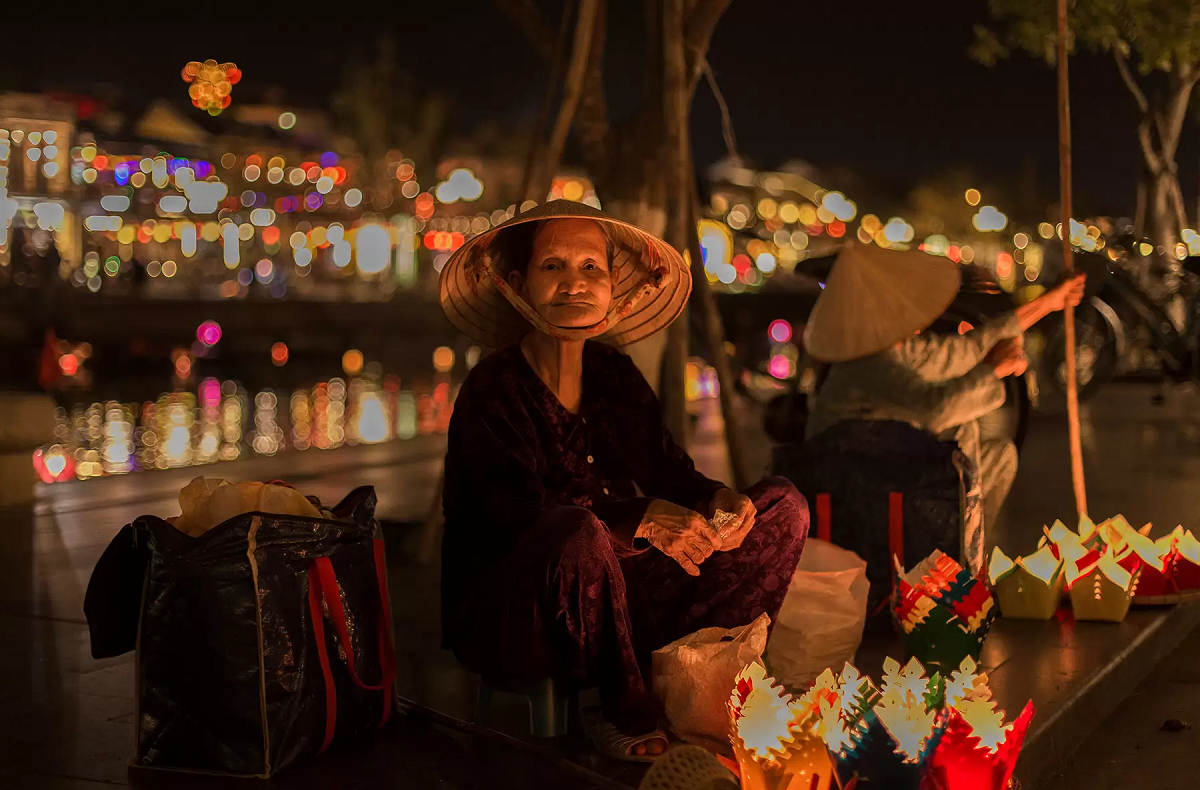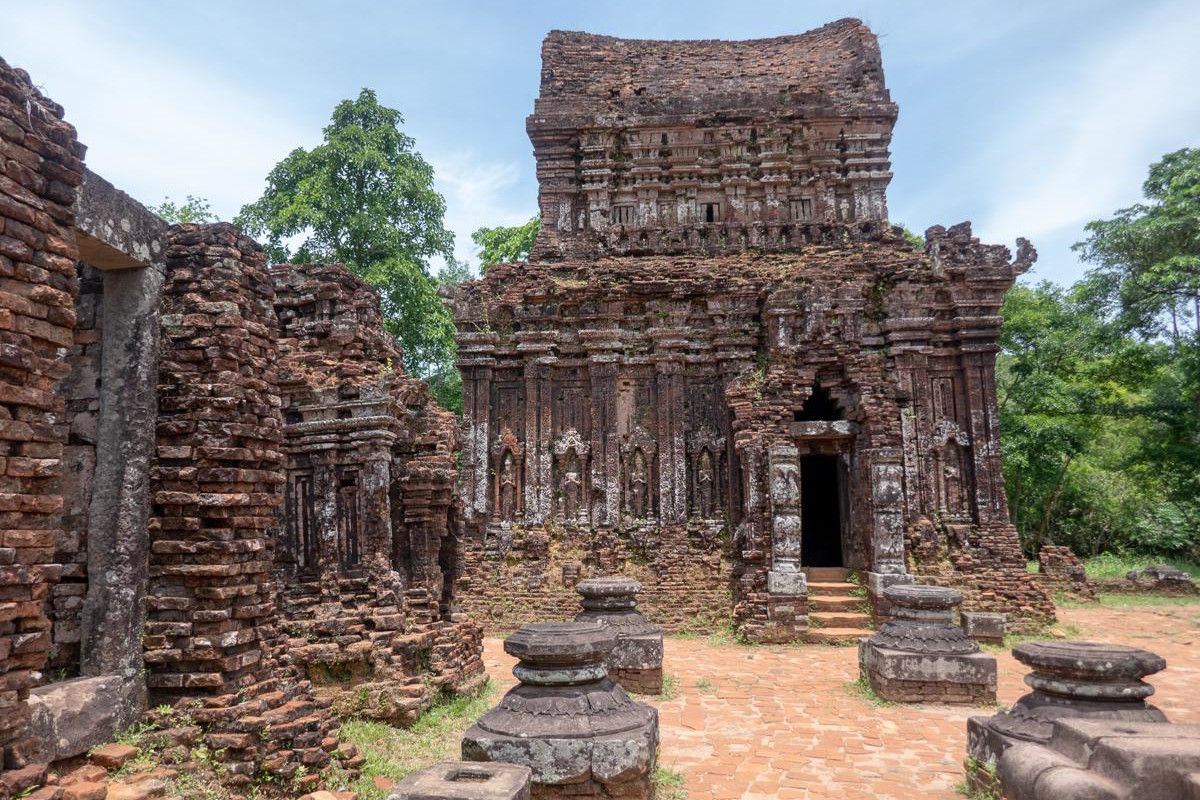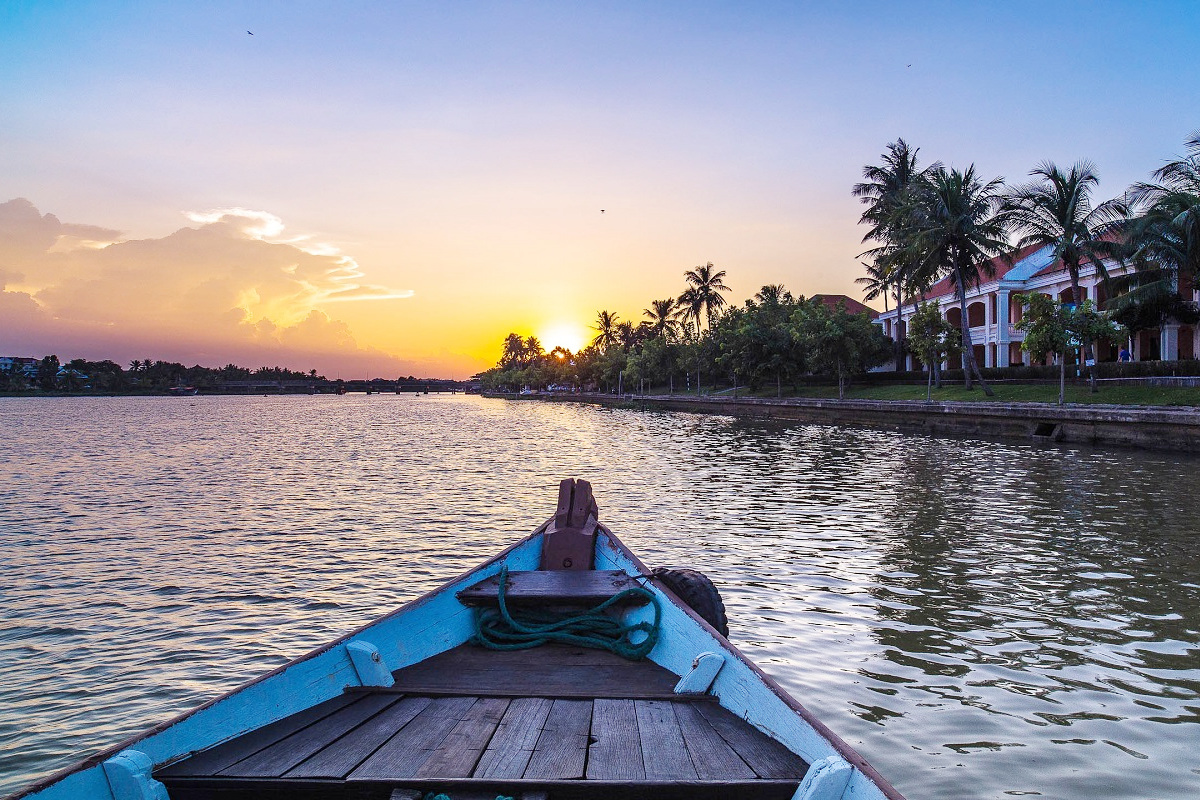In the heart of Da Nang, the Han market is a popular place for visitors to buy something to bring home due to the diversity of merchandise. Back to history, it was built by French people as a part of a new construction project for the new protectorate Tourane. Up to the present, it’s still busy and known as the main hub of commerce or the central marketplace of the entire city. Its surrounding area is the core of the 4th largest urban area of Vietnam.
In this market, visitors can see many options to shop, including souvenirs, fashion items, processed foods to eat, and custom made clothings. To talk (and bargain) with the sellers, it’s not really a big challenge. They know some basic popular languages that are enough to have a simple communication with buyers. Price depends on each product and quality, but generally, not too expensive thanks to the management of local authorities. That are to explain why Han market draws plenty of shoppers.
Near the Han market, visitors can see many restaurants (including the ones serving local foods), coffee shops, spas and the Da Nang cathedral – a well-known instagrammable spot of Da Nang. As a center of commerce, the area has banks, ATMs, money exchangers and jewellery stores too.
Read also:
- Con Market Travel Guide
- Da Nang Night Market
- My Khe Beach Travel Guide
- The Marble Mountains Travel Guide

Table of content
- 1 Han Market Introduction
- 2 Han Market Da Nang Opening Hours
- 3 History of Han Market in Da Nang
- 4 Location of Han Market and How to Get There
- 5 In the Surroundings of Han Market
- 6 Han Market vs Con Market
- 7 Han Market vs Son Tra Night Market
- 8 Da Nang City Tour with Local Guide
- 9 Han Market on Google Maps
- 10 Related Posts
- 11 Non Nuoc Beach: The Famous Beach of Da Nang
- 12 How to Get from Da Nang to My Son Sanctuary
- 13 Bach Ma National Park: Hiking, Trekking in Da Nang and Hoi An
- 14 Am Phu Cave (Hell Cave) – Things to Do in Da Nang
- 15 Asia Park and Sun Wheel in Da Nang (Sun World Da Nang Wonders)
- 16 How to Get to Golden Bridge from Da Nang
- 17 Da Nang Food Specialties: What to Eat in Da Nang
- 18 How to Visit Golden Bridge Vietnam
- 19 Da Nang Shore Excursions: Guided Tours From Tien Sa Port
- 20 Han Market (Cho Han): Where to Shop in Da Nang?
- 21 Da Nang Cathedral (Da Nang Pink Church)
- 22 Things to Do in Ba Na Hills Besides Golden Bridge
- 23 Da Nang Half Day Tours
- 24 Da Nang Private Car and Driver
- 25 Da Nang and Hoi An Itinerary for Visitors Staying Overnight in Hoi An
- 26 Da Nang Things to Do: Guide to What to Do in Da Nang Vietnam
- 27 Da Nang Best Things to Do and Reasons
- 28 How to Get From Hoi An to Da Nang
- 29 Hoi An or Da Nang: Which is Better for First Time Visitor?
- 30 My Son Sanctuary Tour
- 31 Da Nang Best Area to Stay: Guide to Where to Stay in Da Nang
- 32 Da Nang Cave Tour: Best Underground Activities in Da Nang
- 33 Da Nang Best Time to Visit: Guide to Best Weather in Da Nang
- 34 Da Nang Weather by Month: Guide to Monthly Weather in Da Nang
- 35 What to Do in Da Nang At Night
- 36 Lang Co Vietnam Travel Guide
- 37 What to Do in Da Nang for 3 Days
- 38 My Khe Beach: A Complete Guide to Da Nang’s Best Beach
- 39 Da Nang Day Trips: Guide to Best Day Tours From Da Nang
- 40 Museums in Da Nang
- 41 Linh Ung Pagoda: Trio of Da Nang’s Holiest Mountain Temples
- 42 Da Nang Night Market: A Thing To Do in Da Nang at Night
- 43 Guide to Son Tra Mountain (Monkey Mountain) in Da Nang, Vietnam
- 44 Ba Na Hills Tour
- 45 Da Nang Cable Car
- 46 How to Get from Da Nang Airport to Hoi An
- 47 Da Nang to Hoi An: Best Da Nang Airport Transfer and More
- 48 Hai Van Pass Da Nang: Map, Route, Weather, History, Tour
- 49 Da Nang Attractions Guide: What to See in Da Nang Vietnam?
- 50 Guide to Lady Buddha (Goddess of Mercy) in Monkey Mountain, Da Nang
- 51 My Son Sanctuary Travel Guide
- 52 Da Nang Museum of Cham Sculpture
- 53 Dragon Bridge Da Nang: The Fire-Breathing Da Nang Bridge
- 54 Ba Na Hills Travel Guide: A First Timer’s Complete Guide
- 55 Golden Bridge Da Nang: A Guide to The Iconic Da Nang Bridge
- 56 Da Nang Bridge: A Guide to Famous Bridges in Da Nang
- 57 Ba Na Hills Cable Car: World Record, Cost, Reschedule, Map
- 58 Da Nang Mountain Temple: Marble Mountain’s Pagodas, More
- 59 Da Nang Caves: Underground World of the Marble Mountains
- 60 The Marble Mountains: Guide to Da Nang’s Iconic Mountain
- 61 Featured Tours and Experiences
- 61.0.1 Bach Ma National Park Tour from Hue
- 61.0.2 Bach Ma National Park Tour from Da Nang/Hoi An
- 61.0.3 Hoi An Sunrise Fish Market Tour
- 61.0.4 My Lai Massacre Tour
- 61.0.5 Golden Bridge/Ba Na Hills & Hoi An Tour
- 61.0.6 Hoi An Instagram Tour
- 61.0.7 Ky Anh Tunnel & Tam Thanh Mural Village Tour
- 61.0.8 Da Nang to Hue Motorbike Tour with Hai Van Pass & Easy Rider (1 Way)
- 61.0.9 Hue to Da Nang Motorbike Tour with Hai Van Pass & Easy Ride (1 Way)
- 61.0.10 Hue to Hoi An Motorbike Tour with Hai Van Pass & Easy Rider (1 Way)
- 61.0.11 Hoi An to Hue Motorbike Tour with Hai Van Pass & Easy Rider (1 Way)
- 61.0.12 Tra Que Vegetable Village Tour with Cooking Class
- 61.0.13 Ba Na Hills Half Day Tour from Hoi An
- 61.0.14 Marble Mountain & Hoi An Day Tour from Da Nang Port
- 61.0.15 Hue Day Tour from Chan May Port with Lunch
- 61.0.16 Marble Mountain & Hoi An Tour from Chan May Port
- 61.0.17 Ba Na Hills/Golden Bridge Tour from Da Nang Port
- 61.0.18 Ba Na Hills/Golden Bridge Tour from Chan May Port
- 61.0.19 Golden Bridge Private Tour with Ba Na Hills & Lunch
- 61.0.20 Ba Na Hills Afternoon Tour with Golden Hands Bridge
- 61.0.21 Ba Na Hills Private Tour with Golden Hands Bridge
- 61.0.22 Ba Na Hills Half Day Tour with Golden Bridge
- 61.0.23 Ba Na Hills Early Morning Tour to Beat the Crowds
- 61.0.24 Golden Bridge and Ba Na Hills Night Tour
- 61.0.25 Golden Hands Bridge Tour In Sunrise or Sunset (1/2 Day)
- 61.0.26 Cam Kim Island Bicycle Tour From Hoi An
- 61.0.27 Cham Island Tour From Hoi An (Group Tour)
- 61.0.28 Cham Island Tour From Da Nang (Group Tour)
- 61.0.29 Hoi An Vegetarian Food Tour
- 61.0.30 Hoi An Evening Walking Food Tour with Local Foodie
- 61.0.31 Private Hoi An Basket Boat Tour (Shuttle Bus, Bicycle, Bike)
- 61.0.32 Half-day Am Phu Cave Tour (Private)
- 61.0.33 Hoi An Countryside Tour by Electric Car or Bike
- 61.0.34 Da Nang Tour Package From Singapore
- 61.0.35 Hoi An Evening Tour From Da Nang with Lantern Boat Ride
- 61.0.36 Hoi An Walking Food Tour Through Laneways
- 61.0.37 My Son Sanctuary and Hoi An Old Town Tour
- 61.0.38 My Son Day Trip From Hoi An including Marble Mountains and Basket Boat
- 61.0.39 Half Day Hoi An City Tour With River Cruise
- 61.0.40 Son Tra Peninsula Tour with Marble Mountains (Private/Small Group)
Han Market Introduction
Han Market (Cho Han) is one of the central markets in Da Nang, the capital city of central Vietnam and the 4th biggest city of Vietnam. It’s popularly known now as a good place to go shopping for local products in town. Visitors will see a diversity of things here to bring home that are for sale at not expensive prices. Thanks to efforts from the authorities, it’s not wet, smelly, dark, and the sellers are not allowed to cheat buyers. They also can speak a bit of English, Chinese Mandarin and Korean languages.
This Da Nang’s busiest tourist market has two levels, with the main entrance facing Tran Phu St and the back to Bach Dang St. Its ground floor is used to sell souvenirs, local sweets, fruits, vegetables, fresh meats, dried seafood, cooked foods and local specialties – fish cakes (chả cá), beef sausage (chả bò), fish sauces (mắm). By the staircases, correct balance is placed to check the weight and free testers are available to check the preservatives in foods.
Fabric and ready-to-wear fashion are upstairs, including clothes, dresses, shoes, hats, bags, underwear, shocks, and traditional Vietnamese costume for ladies (áo dài). If áo dài is not perfectly fitted to the body, nearby tailors will fix quickly (they are working behind fabric kiosks!). Custom made dresses and suits are also available. However, the tailoring service in Hoi An seems to be better.
Near the Han market, visitors have the chance to exchange money too. All kinds of popular currencies (cash) are accepted, to exchange to Vietnam dong and vice versa. There are so many banks and ATMs in its surrounding area also.
Fact: Local people call Han market because it stands by the Han river. About the origin of “Han”, they explain that the bay of their city (Da Nang bay) looks like a barrel and it’s leaky at the estuary of the river. So, the bay needs to be “welded”. Han means “welding” in Vietnamese. See more in Han river guide.
Read also: Hoi An Central Market
Han Market Da Nang Opening Hours
Everyday, Han market opens from 6 am to 7 pm. If coming to it earlier, visitors may see sellers and what they sell, like fresh meats, seafood, vegetables and breakfast. Many locals wake up early in the morning and then go to parks by the river to do exercise. By that, they want to buy something to eat and cook at home later. The time by 9 am is perfect to watch the life of citizens. 9 am onwards, tourists start visiting it to buy something, so it’s bustling then.
Han market is still a traditional Vietnamese market. For locals, they don’t prefer to buy stuff (not to eat) before 10 am because sellers believe that the first customers decide how lucky they are on the day. So, people have to buy for them or not bargain too much. This belief is still living, although not a lot anymore. If having time, lunchtime onwards will be better. Unlike other markets, there are no pickpockets and beggars here. By the way, on the stairs to upper levels, visitors can put money into donation boxes for orange-agent victims in Da Nang.
Read also: Bridges in Da Nang
History of Han Market in Da Nang
Following the Treaty of Hue in 1883, the government controlled by Nguyen emperors recognized the French protectorate in central Vietnam. 5 years later, the French officially established “Tourane” – their colonial city by the Han river that is called “Da Nang” today. Some people explain that Tourane is a misspelling of “Cua Han” in Vietnamese (meaning “the estuary of Han river”). Then, the colonists started planning quarters with grid streets and urban buildings, including city hall, church, post office, museum, railways and sure, a market.
Originally, the Han market (or Tourane market) had a market and trading streets on both sides. One-storey shop houses lined these streets, selling wholesale consumer goods and foods. The owners were mainly Chinese people and a bit Vietnamese. To connect with the rest of the city, the French also built railways and a ferry. Until the first bridge constructed to span Han river in 2000, the ferry was still in use (called “Han market ferry”). Inside the main building – the market, a wide range of products were for sale. Because there are only people in high classes coming to shop, locals say that it is “rich people market”.
After two wars between France and America, Han market was rebuilt in 1989 and to the present day, it doesn’t change a lot. It still plays its role as an important hub of commerce in the city.
Read also: Museums in Da Nang
Location of Han Market and How to Get There
Where is the Han Market?
Han market is in the core of Da Nang city, therefore it’s very convenient to get to Han market and vice versa. Its address is 119 Tran Phu St, Hai Chau 1 ward, Hai Chau district. This market also has door opening to Hung Vuong and Nguyen Thai Hoc streets, and especially, Bach Dang St (Han river bank). Roads in the front and back of the market allow one-way traffic. For that reason, tourists have to walk across them to access it.
Walking
If staying in hotels within Hai Chau district, it’s easy to reach the Han market by foot. The best way is still walking on the promenade by the Han river. It’s wide, free from “crazy” traffic and allows to see unique bridges of the city. Additionally, also friendly to wheelchair users and toddles. To get to the Han market, pedestrians need to go across Bach Dang street and remember to observe carefully to reach the opposite side safely. Luckily, vehicles move in one direction only, so “the game” may be easier. A gate of Han markets faces this road.
Because there are many great places to try local foods, the Han market and its surroundings is the host for Da Nang walking food tour.
Car and Taxi
Getting to Han market by car and taxi is convenient from everywhere in Da Nang city thanks to its prime location. If want to check how much the taxi charges, travelers can check the distance on the map in kilometers and multiply by around 15,000 VND. Passengers have to pay by cash for the driver. People in the hotel can help to have one to reach Han market, and then it’s not difficult to see a taxi there to go somewhere.
For a full-day exploration around the city, travelers should have a private car and driver. It’s not all about the cost, it’s a convenience and time saving. And sure, Han market is one of the stops. Text us in whatsapp number +84968009827 to assist a recommended itinerary and the price.
Bus
Han market is accessible by public bus. On the left bank of the river, visitors can get R17A bus that runs from Cang Song Han (“Han river harbour”) to the center of Hoa Vang district. In the city down, this bus picks up and drops off along Nui Thanh, Hung Vuong, Nguyen Thi Minh Khai and Ly Tu Trong streets. Its operation hours are between 6 am and 7 pm. Ticket price is about 6,000 VND. The nearest places to the Han market are at Bach Dang St (walking across the street then) and the Pink church (need to have a short walk and then across the street). Keep in mind to be careful while walking across roads because the traffic is usually high. Should go with locals if you see someone.
If traveling by buses and vans by yourself, a spot by Bach Dang street (right side) is designed for tourist vehicles only. It’s possible for drivers to pick up and drop off there.
Motorbike
Motorcycle is the most popular vehicle in Vietnam. Tourists can hire a bike and get around Da Nang city by themselves (make sure that the license is available!). The rental fee often doesn’t include gasoline and accident insurance, but the fuel price is really cheap (around 1 usd for one liter). Parkings are around the market.
Our advice is to have a full-day rental. Visitors can self-organize a Da Nang city tour to cover famous landmarks, such as the Pink church, Museum of Cham sculpture, 67-meters-tall Lady Buddha or the Marble mountains.
Read also: How to Get to Golden Bridge from Da Nang
In the Surroundings of Han Market
The Da Nang Cathedral
Completed in 1924, the Da Nang cathedral still is the only Catholic church built by French people in Da Nang’s centre. It’s popularly known as the Pink church for tourists and the Rooster church for locals. People just need to walk from Han market to visit and photograph at this place. Sometimes its main entrance (facing Tran Phu road) opens but sometimes, it’s needed to access it by a door in Yen Bai road. See full details and mass times in Da Nang cathedral travel guide.
Local Restaurants near Han Market
Around the Han market, there are many Vietnamese restaurants. These venues serve both local foods and fusion cuisine, and mainly family businesses. It’s not hard to see a Pho eatery where people come to try traditional beef noodle soup that is seen as Vietnam’s national food. Pho xao – stir fried noodles and Com chien – fried rice are also available, with beef and chicken. Luckily, the staff understands English (although not much).
Banh mi sandwich is sold at several spots near the gate by Bach Dang road of the market and in nearby Hung Vuong road. Da Nang local cuisine is known for a banh mi filled by cha ca – fried fish cakes, pate, veggies and bolt sauce. The long version is called “stick bread” (banh mi que) with less fillings.
Other dishes that visitors can expect to taste are banh xeo – rice pancakes, nem lui – grilled pork skewers, bun thit nuong – grilled pork and rice vermicelli, banh beo – rice cake in bowls, com tam – broken rice with pork barbecues, bun mam nem – rice vermicelli with anchovy sauce and more.
Therefore, the surrounding of the Han market is great to have a food tour, no matter by yourself or with a local guide. You can see our Da Nang walking food tour.
Coffee Shops near Han Market
Coffee is one of the most popular drinks in Vietnam. So surprise that there are many coffee shops by the Han market, including famous names and brands. Travelers often go to Cong Caphe, a communist-style shop with different Vietnamese coffee options. Staff here know English and the menu is written in English too. Coconut milk coffee is among the best sellers. Not far away, Ut Tich coffee shop serves coffee made by local beans that are grown and brought from the Central highlands, the largest cultivation region in the country. If seeking somewhere more local, visitors can go to inner streets, to try true local coffee and know true drinking culture. The price there will be cheaper but waiters have no or broken English. Let’s use online translation to make communication easier.
Read also: Museum of Cham Sculpture in Da Nang
Han Market vs Con Market
Con Market (Cho Con) is another large traditional market in Da Nang centre. It’s not far away from the Han market too. Therefore, getting there is convenient by all kinds of road vehicles. Like the Han market, visitors can see a diversity of products to buy and delicious foods to eat. If the price in this one may be cheaper and more local, the quality is the first thing that buyers should know before visiting it. Sometimes, the quality is not good value for money. In Han market, the management is better because it’s seen as a “tourist market” and of course, if someone cheats you, the problem will be figured out quicker. Additionally, the sellers don’t know English much (not to mention other languages) in Con market, making the shopping experience not really smooth.
We advise reading our visitor guide to Con market to have more information.
Han Market vs Son Tra Night Market
Son Tra Night Market (Cho Dem Son Tra) is the biggest night market in Da Nang. It’s located by the right bank of the Han river and the Dragon bridge. More than 150 souvenir and food stalls are here, on the street, providing visitors with many options to buy. It’s quite fair between this and the Han market. Both places serve mainly for tourists, so sellers know English to talk. About the price, nowhere it’s cheaper. The big difference between them is the opening hours, one in the daytime and the other in night time. Many people visit Son Tra night market because they like to watch the fire and water show at the Dragon bridge on the weekend.
We advise reading our complete guide to Son Tra night market for further information.
Da Nang City Tour with Local Guide
Read also: Full-day Da Nang City Tour
A full-day Da Nang city tour includes the Han market. In the morning, visitors may sightsee the Marble Mountains – a group of spectacular hills with amazing caves, ancient temples and colorful handmade marble sculptures and Linh Ung pagoda in the Monkey mountain. This 2010-built pagoda boasts of the tallest Lady Buddha in the country. It’s 67 meters in height. To get to these famous mountains, travelers absolutely can see a long, white sandy coastline with coconut palms. The most popular swimming spot is named “My Khe beach” that was ever in the top 6 of the sexiest beaches of the globe by Forbes.
After lunch, visitors continue exploring Da Nang city’s landmarks. In addition to having free time to visit and go shopping in the Han market, Da Nang cathedral, Museum of Cham sculpture and the Dragon bridge are other stops. The first building represents French colonial time and it’s a must see for instagrammers. It has a photogenic pinky façade. The Da Nang museum of Cham sculpture was also established by French people (in 1919), in order to preserve priceless, elaborate sandstone sculptures of Champa kingdom. This collection is the largest in Vietnam, and of course, is only in the world. Next to it, the Dragon bridge has the most unique design for one urban bridge in the country.
Han Market on Google Maps
Related Posts
Non Nuoc Beach: The Famous Beach of Da Nang
Besides the Golden hands bridge – a global hit, Da Nang city also has beautiful beaches. If looking for somewhere great to stay and have a slow holiday, Non Nuoc
How to Get from Da Nang to My Son Sanctuary
Known as ‘the Angkor Wat of Vietnam’, My Son sanctuary boasts of its sophisticated temples dating back from 4th century. Sadly, in 14th century, it’s abandoned in the forests. Today,
Bach Ma National Park: Hiking, Trekking in Da Nang and Hoi An
Two best places for trekking and hiking in and near Da Nang are Son Tra mountain (peninsula) and Bach Ma national park. Which one is better is actually personal because these
Am Phu Cave (Hell Cave) – Things to Do in Da Nang
Although in the Marble mountains – the most visited attraction in Da Nang, travelers often miss Am Phu cave. One of reasons is that it’s mentioned much online and not
Asia Park and Sun Wheel in Da Nang (Sun World Da Nang Wonders)
Have you ever seen the wheel of Da Nang? That is the Sun Wheel. It’s a part of greater Asia Park – an amusement park with a heap of fun
How to Get to Golden Bridge from Da Nang
The Golden Bridge (aka the Golden Hands Bridge) in Da Nang is a must visit attraction in Vietnam today. Many foreign travelers come to the city, just because they love
Da Nang Food Specialties: What to Eat in Da Nang
Da Nang is known as a food capital of central Vietnam. This city boasts many yummy dishes, prepared by distinctive recipes and some of them are famous all over the
How to Visit Golden Bridge Vietnam
The Golden Hand Bridge of Ba Na hills today is a dream place to visit for many travelers. Since it opened in June 2018, millions of people have set their
Da Nang Shore Excursions: Guided Tours From Tien Sa Port
Da Nang Vietnam today is one of stopovers for many cruises that travel from continent to continent, from country to country. It owns an ideal seaport to moor and it
Han Market (Cho Han): Where to Shop in Da Nang?
In the heart of Da Nang, the Han market is a popular place for visitors to buy something to bring home due to the diversity of merchandise. Back to history,
Da Nang Cathedral (Da Nang Pink Church)
Da Nang became a French protectorate on 3rd October 1888, under the name “Tourane”. By the Han river, the colonists designed a grid of streets with public buildings, a city hall,
Things to Do in Ba Na Hills Besides Golden Bridge
According to local authorities, 50% of visitors coming to Da Nang and Hoi An visit the Ba Na hills. In other words, that is nearly 10 millions of people. This
Da Nang Half Day Tours
In addition to day trips, travelers have many options of half-day tours in Da Nang to choose from. Not to spend a full day at different places, maybe far from
Da Nang Private Car and Driver
Your next holiday destination is Da Nang? You prefer to travel by yourself? Hiring a private car is one of the best options for you to explore with freedom, flexibility
Da Nang and Hoi An Itinerary for Visitors Staying Overnight in Hoi An
Da Nang and Hoi An are twin cities in the heart of Central Vietnam. Both are popular tourist destinations for either domestic or international visitors, and share many similarities. Due
Da Nang Things to Do: Guide to What to Do in Da Nang Vietnam
Unquestionably, Da Nang deserves a holiday trip from all types of traveller. Firstly, due to the weather. It has a longer sunny time than the north but less hot than
Da Nang Best Things to Do and Reasons
Da Nang is the largest tourist center in Central Vietnam. It owns fascinating natural and cultural places that attract both Vietnamese and foreigners. In the busiest year, this city of
How to Get From Hoi An to Da Nang
Da Nang is the neighbouring city of Hoi An. It's the capital of Central Vietnam and has the most important (busiest) transport hubs of the region, such as airport, train
Hoi An or Da Nang: Which is Better for First Time Visitor?
Da Nang and Hoi An are located in Central Vietnam, with a distance of roughly 30 km. To the north, Da Nang is the capital city of the region, with
My Son Sanctuary Tour
My Son Sanctuary is a Unesco world heritage site, attracting 450,000 visitors in recent years. It’s the best remains left by the fallen Champa Kingdom which ruled a part of
Da Nang Best Area to Stay: Guide to Where to Stay in Da Nang
In the Central coast, Da Nang has an area of 1,285 km2 and population of 1,134 people, making it become Vietnam’s 4th largest city. It plays an important role in the
Da Nang Cave Tour: Best Underground Activities in Da Nang
Different from Hue and Hoi An, Da Nang has limestone caves and grottoes. All of them are within the Marble Mountains (Ngu Hanh Son), a complex of 5 amazing hills
Da Nang Best Time to Visit: Guide to Best Weather in Da Nang
Da Nang is titled “Asia’s leading festival and event destination” by the World Travel Awards or Vietnam’s greenest city by the WWF. Its reputation comes from amazing natural mountain-to-sea sceneries,
Da Nang Weather by Month: Guide to Monthly Weather in Da Nang
In Central Vietnam, Da Nang has a tropical monsoon climate with two distinct seasons that each starts later than the North 2 months. Because of being shielded by the spectacular
What to Do in Da Nang At Night
Between the sunset and midnight, there are many things to do in Da Nang that travelers should know before getting to bed. Thankfully, different styles of traveling, budget or ages
Lang Co Vietnam Travel Guide
Lang Co was a lovely backwater town nestled at the foot of spectacular Hai Van Pass for some decades. Not yet widely known because of the popularity of beaches in
What to Do in Da Nang for 3 Days
Da Nang is a lovely coastal city in the middle of 3 Unesco world heritages Hue, Hoi An and My Son Sanctuary. This most worth-living municipality owns a poetic river
My Khe Beach: A Complete Guide to Da Nang’s Best Beach
Da Nang is a lovely seaside city with many beaches, and the best is My Khe. Located on the eastern coastline, it’s between little-known beaches near the foot of Son
Da Nang Day Trips: Guide to Best Day Tours From Da Nang
Centre and outskirts of Da Nang have incredible attractions where travellers need to spend many hours to get to and fully explore. There are the Ba Na Hills and Golden
Museums in Da Nang
Da Nang has many museums where visitors can see and learn a lot. Generally, their exhibitions have different themes, varying in stages of the history, groups of people (communities) having
Linh Ung Pagoda: Trio of Da Nang’s Holiest Mountain Temples
Linh Ung means “wishes answered miraculously” in Sino-Vietnamese. And it’s first used in 1841 to name a pagoda in the Marble Mountains by Thanh Thai, the 10th king of the
Da Nang Night Market: A Thing To Do in Da Nang at Night
Different from day markets in Da Nang, night markets are held open-air and on streets where traffic is active during sunny hours. A visit there provides the chance to understand
Guide to Son Tra Mountain (Monkey Mountain) in Da Nang, Vietnam
From My Khe Beach or Han River promenades, tourists can see a part of the Son Tra Mountain. Although being near the city center, natural forests on its slopes have
Ba Na Hills Tour
Ba Na Hills is one of the best attractions in Da Nang, and the country. Its full name is the Ba Na-Suoi Mo Tourist Area, made from “Ba Na hill
Da Nang Cable Car
No surprise that now, when travelers make the plan to tour around Vietnam, there are many cable car rides recommended. Some are top things to do in its cities. The
How to Get from Da Nang Airport to Hoi An
Located in the city of the same name, Da Nang airport is the nearest airport to Hoi An. So, if travelers want to see an extremely-colorful Lantern festival or try
Da Nang to Hoi An: Best Da Nang Airport Transfer and More
If traveling to Hoi An by air, train and cruise ship, visitors will come to Da Nang first and then have a transfer. The largest city of Central Vietnam holds
Hai Van Pass Da Nang: Map, Route, Weather, History, Tour
Truong Son or Annamite Range is the most dramatic mountain ridge in Vietnam. When it juts out into the sea, spectacular Hai Van Pass is formed. This amazing sculpture of
Da Nang Attractions Guide: What to See in Da Nang Vietnam?
Da Nang is the capital city of the Central region, and one of the most attractive destinations to tourists in Vietnam. It’s established by French colonists and called by them
Guide to Lady Buddha (Goddess of Mercy) in Monkey Mountain, Da Nang
From the East coast, visitors can see an enormous white statue with the mountain backdrop, that is the Lady Buddha Da Nang. Located in the ground of Linh Ung Pagoda,
My Son Sanctuary Travel Guide
My Son Sanctuary is a complex of Hindu temples and a Unesco world heritage site from 1999. It’s 40 km away from Hoi An and 70 km to the southwest
Da Nang Museum of Cham Sculpture
Da Nang Museum of Cham Sculpture is a highlight of the Han river waterfront. It’s established by French archaeologists to preserve intricate works of art of Champa kingdom, which ruled
Dragon Bridge Da Nang: The Fire-Breathing Da Nang Bridge
Praised to be the world's 30 most unique bridges recently, Dragon Bridge became the new icon for a Han river bridge in Da Nang. Spanning from the 100-years-old Cham Museum,
Ba Na Hills Travel Guide: A First Timer’s Complete Guide
50% of visitors to Da Nang plan to visit Ba Na Hills in their itinerary. It’s larger for first timers who may know about its inspirational Golden Bridge, world-record cable
Golden Bridge Da Nang: A Guide to The Iconic Da Nang Bridge
Recently-built but at the present time, the Golden Bridge Da Nang is one of the awaited attractions in Vietnam. On a slope of high foggy mountain, this delicate bridge and
Da Nang Bridge: A Guide to Famous Bridges in Da Nang
Da Nang has many bridges, and some of them are famous nationally and internationally. Before the recently-built Golden Bridge which made a boom in social media, people only knew bridges
Ba Na Hills Cable Car: World Record, Cost, Reschedule, Map
Cable car is one of the first ideas travelers think about Ba Na Hills, a Da Nang’s top attraction. It helps to shorten the time to get to the hills
Da Nang Mountain Temple: Marble Mountain’s Pagodas, More
Da Nang has many mountain temples where handmade architecture, natural sceneries and religious values are combined perfectly. So, travelers will see, enjoy and learn a lot about different things just
Da Nang Caves: Underground World of the Marble Mountains
One of the priceless gifts Mother nature gives to Da Nang is an array of caves and caverns. Almost all are located in the Marble Mountains, a complex of
The Marble Mountains: Guide to Da Nang’s Iconic Mountain
Had been an offshore group of islands, geological activities shifted the Marble Mountains to the land some thousands of years before. Today, its marble hills rise suddenly up to over 100






